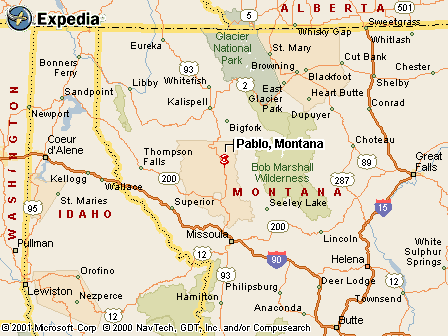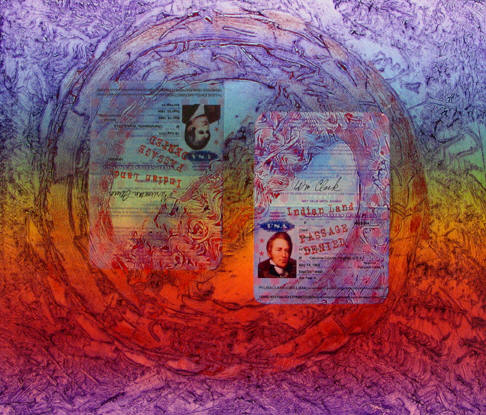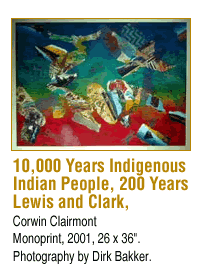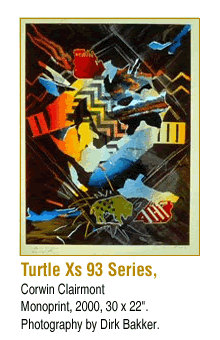 |
Canku Ota
|
 |
|
(Many Paths)
|
||
|
An Online Newsletter
Celebrating Native America
|
||
|
April 1, 2009 - Volume
7 Number 4
|
||
|
|
||
|
Provocative Perspective
|
||
|
by Lynnette Hintze -
the (Kalispel, Montana) Daily Inter Lake
|
||
|
PABLO, Mont. (AP) — Works by renowned American Indian artist rife with irony, paradox Chunks of asphalt suspended from the frame of a teepee over a bed of aerial maps. Shreds of old tires, cast in rubber molds and shaped into a war shield that's split down the middle with a white zigzagged line. A door frame wallpapered with real-estate ads and pictures of American Indians, the word SOLD sprawled in bold letters. The title: "Welcome to the Res."
The Artist is Immersed in the Culture "For me, art is about life," Clairmont said in a reserved, soft-spoken tone that belies the brash force of his artwork. "Anything you're engaged in gives substance that might filter into a project. You have to be a participant in life." As a longtime assistant vice president and art instructor at Salish Kootenai College in Pablo, Clairmont is immersed in the culture from which he draws inspiration for his art. One of his most recent works, "Indian Country Passage Denied," is a perfect example of the provocative nature of his work. The collagraph depicts modern-day passport images of Lewis and Clark against a colorful background meant to reflect American Indians' rich past. In a portfolio of Clairmont's prints, "Native Perspectives on the Trail," the commentary points out that Lewis and Clark's historic expedition "was one of exploration but also the demonstration of arrogant superiority and the cementing of territorial lines. "Lewis and Clark did not proceed as guests in a foreign land, but as conquerors ... Clairmont's print leads us to ask: 'What if Lewis and Clark needed passports and what if their passage had been denied?'" Injustice Against Indians a Favorite Theme
His mixed-media piece, "Asphalt Storm Cloud Over the Reservation," with asphalt pieces suspended from a teepee frame, was completed in the early 1990s as the state contemplated widening U.S. 93 into a four-lane highway. "When you put a road in and take a hillside out, in essence you're taking a page out of our book," he reflected. "The land becomes more fragmented, and it's done many times without conscience. Sacred sites are destroyed. We don't have a loud voice to talk about those things. Through the arts, it gives us more of a voice. "I'm a member of the tribe and that means a lot to me," Clairmont said. "I'm sensitive to Indian issues. If you're a native person, where you are contains all your stories." His Mount Rushmore Commentary Sparked Controversy
His work has sparked controversy on several occasions. Perhaps the most vocal outcry was spurred by a piece called "Paha Sapa," depicting two families — one white, one red — viewing Mount Rushmore. The Euro-American family has the faces of the U.S. presidents reflected in their glasses, but the Indian family has four skulls reflected and positioned in the same places as the presidents' heads, implying the Lakota's disdain over what they see as a desecration of a mountain into a tourist trap. School trips to the Paris Gibson Square Museum where the piece was on display were canceled as the controversy raged in the mid-1990s. As well-known American Indian artist and poet Gail Tremblay explained, "any native person with a sense of history understands the content of this work instantly," recounting the hand America's earliest presidents had in destroying the Indian culture. "There is great truth in his works," Tremblay said in an Missoula Art Museum catalog about Clairmont's artwork. "And like the elements he uses such as rocks and earth, they are timeless. Corwin Clairmont makes art that speaks with a clear voice, and this large world needs to hear it." Encouraged by His Parents
"Mainly, I liked doing it," he recalled about his formative years. "My parents encouraged me to a degree because of my ability to render things fairly well at an early age. I knew pretty early on that I wanted to do something with the arts." As a boy, paint-by-number kits that routinely turned up as Christmas gifts didn't make any sense to him. "They bored me to tears," he said. "I don't know if I ever finished one." During high school in Polson, an art instructor began to introduce Clairmont to different elements of art. A traveling artist came through during his sophomore year, demonstrating how to paint acrylic landscapes with a pallet knife. "That was the first time I really tried painting," he said. A Seal he Designed at 15 is Still Used At 15 he designed a tribal seal as part of a contest on the reservation. He won, and still today his rendering is the official seal of the Confederated Salish and Kootenai Tribal Nation. After studying art at the University of Montana and Montana State University and earning an art degree, he was off to California to complete his master's degree in art from California State University. Clairmont made his mark in the avant-garde atmosphere of Los Angeles in the 1970s, teaching at the world-renowned Otis Art Institute, one of the best schools at that time for contemporary art. "I felt very lucky to be able to teach there," he said. Grew Up on the Flathead Indian Reservation But in 1984 it was time to come home to the Flathead Indian Reservation where he'd grown up. He wanted to spend time with his father, and got the opportunity to do that before his father passed away that autumn. Salish Kootenai College was just getting its accreditation when Clairmont came home to the reservation. The college didn't have an opening for an art teacher, so he took an administrative position. He took a leadership role in creating an art department at the college, and in 1989 was named director of the college's art programs and assistant vice president, positions he still holds. He had free rein in designing the college's Three Woodcocks art building, and took special care to make sure the facility has "a real presence of our being." It's shaped like a traditional Salish long house, but has abstract teepee-like elements and natural lighting that makes it feel as if one is outdoors even within the building's main corridor. Clairmont's ability to share his love of art is evident among his students, who on this day were pounding and chiseling feverishly to shape Indian flutes. He doesn't stand on a soapbox, though, to instill his beliefs in his young charges. "I bring it up when it's appropriate to do so. There are times and places for it," he said. Hands Out Copies of Treaty that Established Reservation Clairmont has a sizable list of accomplishments. Last year he received the Governor's Arts Award and a hometown celebration was held in Pablo in his honor. He's served as artist-in-residence at several universities, including Rutgers, where he was a print fellow at the Rutgers Center for Innovative Print and Paper. Clairmont's quest in preserving his native heritage is evident in the cards he routinely passes out to those he meets. The compact "gold cards" contain word for word the entire 1855 Treaty of Hell Gate that established the Flathead Indian Reservation. "Read it," he encourages, then with a slight smile adds, "don't leave home without it." |
 Pablo, Montana map |
www.expedia.com |
|
|
||
|
|
||
| Canku Ota is a free Newsletter celebrating Native America, its traditions and accomplishments . We do not provide subscriber or visitor names to anyone. Some articles presented in Canku Ota may contain copyright material. We have received appropriate permissions for republishing any articles. Material appearing here is distributed without profit or monetary gain to those who have expressed an interest. This is in accordance with Title 17 U.S.C. Section 107. | ||
|
Canku Ota is a copyright ©
2000, 2001, 2002, 2003, 2004, 2005, 2006, 2007, 2008, 2009 of Vicki
Barry and Paul Barry.
|
||
 |
 |
|
|
The "Canku
Ota - A Newsletter Celebrating Native America" web site and
its design is the
|
||
|
Copyright ©
1999, 2000, 2001, 2002, 2003, 2004, 2005,
2006, 2007, 2008 of Paul C.
Barry.
|
||
|
All Rights Reserved.
|
||
 There
is nothing traditional about Corwin "Corky" Clairmont's
artwork. In unconventional ways, he's spent a lifetime challenging
the viewers of his work to understand what he has to say. Every
piece of his artwork gives way to ironic twists and turns, full
of social and political commentary as it relates to his American
Indian culture.
There
is nothing traditional about Corwin "Corky" Clairmont's
artwork. In unconventional ways, he's spent a lifetime challenging
the viewers of his work to understand what he has to say. Every
piece of his artwork gives way to ironic twists and turns, full
of social and political commentary as it relates to his American
Indian culture. Time
and time again, Clairmont brings attention to his view of corporate
and governmental injustices imposed on the Indian community and
environment, particularly as it relates to the Flathead Reservation.
There are common threads woven through his work — save the
environment, save the American Indian culture.
Time
and time again, Clairmont brings attention to his view of corporate
and governmental injustices imposed on the Indian community and
environment, particularly as it relates to the Flathead Reservation.
There are common threads woven through his work — save the
environment, save the American Indian culture. The
10,000-year-old history of his people, and the impact "newcomers"
have had on that culture within the past couple of hundred years
is a juxtaposition prevalent in his work.
The
10,000-year-old history of his people, and the impact "newcomers"
have had on that culture within the past couple of hundred years
is a juxtaposition prevalent in his work. Clairmont
came to art early in life.
Clairmont
came to art early in life.